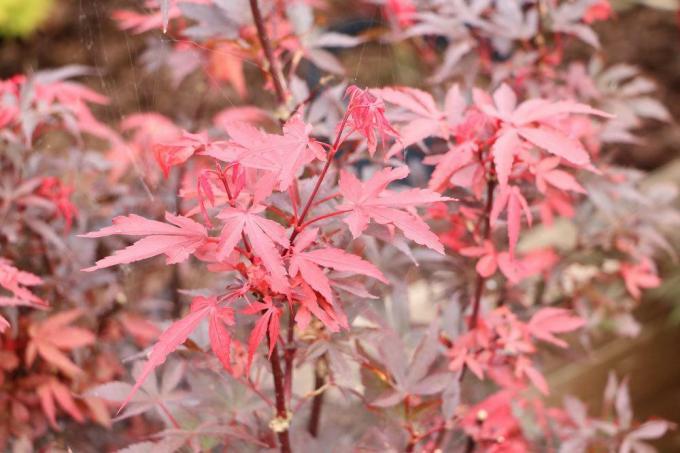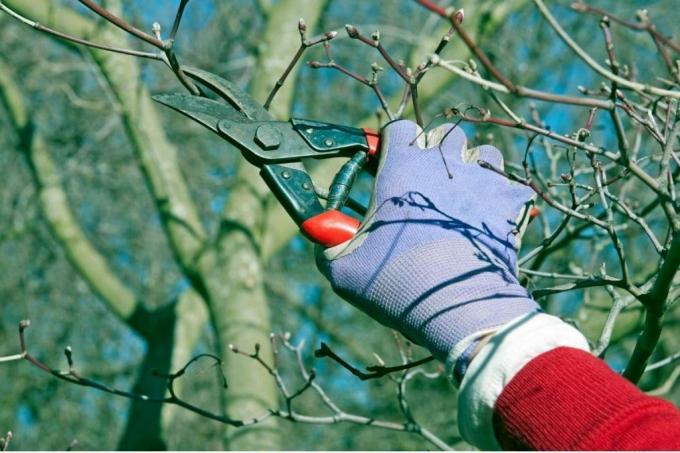
table of contents
- Choice of variety
- Location
- Outdoor or bucket culture
- Winter protection
- Winter in the house
- Blending
- Time and care
- frequently asked Questions
If the maple suffers frost damage, a change of location, pruning or measures to protect it can be useful. We show how to do it.
In a nutshell
- Frost damage can be avoided with appropriate protection
- a change of location can help
- Wintering in the house can be useful
- Cutting back into healthy wood is helpful
- blazing winter sun is harmful
Choice of variety
In any case, prevention is better than cure. It therefore makes sense to choose a variety that is as hardy as possible. This is at least true if the maple is to be planted in the bed. Small varieties that grow slowly are recommended. These include:

- Japanese maple - Acer palmatum
- Golden maple - Acer shirasawanum
- Japanese maple - Acer japonicum
Tip: The compactly growing variants are also ideal in regions with very rough winters, as they can simply be pulled in the bucket and thus more easily protected over the winter.
Location
Prevention also includes choosing the right location for the crop. This should meet the following requirements:
- sheltered from the wind
- no blazing sun, especially in winter
- Protection against heavy rain and waterlogging

A change of location is always advisable to protect the maple and to let it regenerate if the following points apply:
- the plant is particularly young or old
- frost damage occurs again and again
- the crop is weakened by disease or pests
Tip: It is ideal to place the plants in the east or west and close to larger growths or walls. This gives them the protection they need and makes them safer even in winter.
Outdoor or bucket culture
Depending on the variety and the conditions on site, it can make more sense to cultivate the plant in the tub. Bucket culture has a number of advantages. Including:
- quick change of soil possible
- simple winter protection
- Watering and fertilizing can be done very specifically
Possible disadvantages, however, are that the maintenance is a little more complex and the tub culture is only suitable for varieties that remain small. If the plant is planted outdoors, it can slowly get used to cooler temperatures in the first few years. However, care should be taken to ensure that the plant is adequately protected in winter.

Winter protection
A good way to prevent frost damage to the maple is to give the plant appropriate protection in winter. This is especially important if one of the following factors applies:
- very young plants
- old plants
- weakened maple
- Location is exposed
- Winter is particularly cold
- existing frost damage
The winter protection is not only used as a preventive measure, but can also be used retrospectively without any problems in order to avoid further frost damage. It should consist of two parts. On the one hand, the root disc must be covered. Applying a layer of natural materials is advisable for this. Are suitable:
- brushwood
- Bark mulch
- straw

In order to avoid frost damage from blazing winter sun, the maple is protected by a fleece cover. However, this should not be on the plant every day, because light is necessary for the plants. However, it is necessary at very low temperatures and in bright sunshine.
Tip: If the blazing winter sun cannot be avoided, a shade sail or a parasol can also be used as protection for evergreen maple varieties. This makes it unnecessary to repeatedly cover and cover the plant.
Winter in the house
Wintering in the house is particularly easy to prevent further frost-related damage. The maple should be frost-free but light. In addition, a minimum of care is required. Avoid allowing the soil to dry out completely. Light watering if necessary should therefore not be forgotten.
However, waterlogging is also dangerous. The earth should only be slightly damp but not completely saturated with water. Fertilizing should be stopped in late summer.
If the plant has to be rescued because it has already been damaged by too low temperatures, it can also make sense to bring it into the house. This allows the plant to recover faster and further damage is avoided.
Blending
In order to save the maple after frost damage, the damaged parts of the plant must be removed. A Blending early in spring prevents the branches and leaves from rotting or serving as entry points for germs. The following instructions show how to do this:

-
Prepare cutting tool: The secateurs should always be clean. It is ideal to disinfect the blades. In addition, the blades must be sharp. Otherwise, the branches will be pinched and not cut smoothly. This can encourage the penetration of germs and parasites.
-
Plan waste correctly: The affected parts should be cut so far that the waste reaches into the healthy wood. However, this is not always easy to see. However, it can be quickly determined by checking the elasticity and looking at the cut surface. Healthy, living branches are elastic and can therefore be easily bent.
- Carry out maintenance afterwards: After the waste has been cut, the cut surfaces should be able to dry off well. It is therefore important that the measure is carried out on a dry day. In addition, a coordinated fertilization and watering makes sense. This strengthens the plant and allows it to regenerate.
Time and care
If parts of the plant are frozen due to frost, the plant can often regenerate itself after cutting. The only important thing then is that they are adequately watered and fertilized. It can take several weeks before a new bud emerges. So here it is important to be patient.
If necessary, a new cut must be made if sections of the branches do not recover or later die off due to frost damage.
frequently asked Questions
If the plant repeatedly shows signs of frost damage or if growth appears to be delayed, a change of location can make sense and protect the crop. However, a change of location is also possible in winter to give the plant the opportunity to regenerate.
The cutting to save the maple can be done right down to the healthy wood. As a test, the bark can be gently scraped off with a fingernail beforehand or branches can be cut off piece by piece until the cut surface is green, at least at the edge.
If the soil is very dry, it should also be watered in winter. Watering takes place from below and must be carried out on frost-free days. Otherwise, the risk of damage from freezing temperatures is increased.


